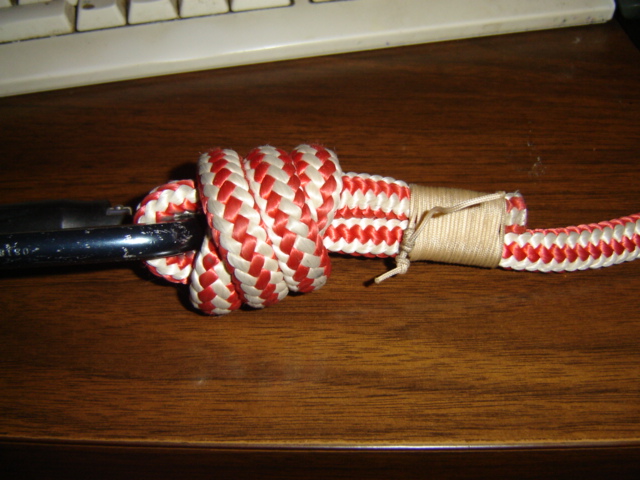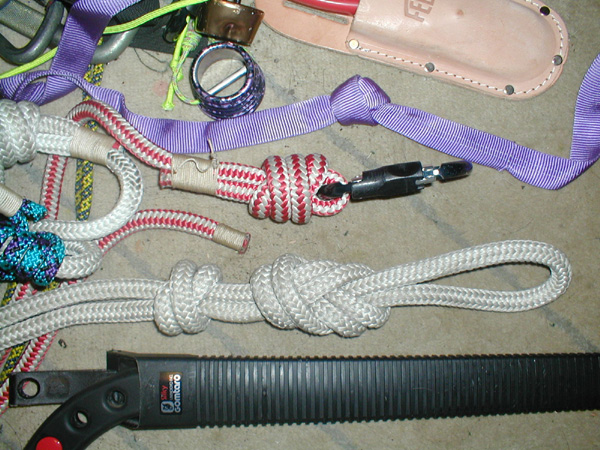There have been a number of posts recently on whipping beeline, splicing beeline, knots failing (Close Call!), and general curiosity about this rope. It is a singularly tough little rope, you can't melt it even if you put a blowtorch on it.
Splicing is difficult for tress cords done with Beeline, because a double braid class II splice requires (using conventional instructions) such a deep insertion that it cannot be effectively done on a short tress cord or prussic loop (splices are pretty easy on longer sections of rope). Installing locking brummels in the commercially spliced loops apparently compensates for the shorter core bury. It helps that a splice is so neat and tidy in a climbing rig, compared to big bulky knots. Unfortunately, the buried tail of the splices also stiffen the rope, so splices don't work as effectively for a friction hitch as just tying the rope to the carabiner.
Some knots are nearly infallible. Then there is the occasional report of a failed knot, and we all start to question the equipment we are using. Soooo....I have what I think is a solution. I have every confidence that you guys will give me all the feedback required to determine if this is a good method of attaching a prussic loop to a carabiner for a friction hitch or to d-rings as a bridge: Add seizing to the tail to secure it permanently.
Use a double (or triple) fisherman knot, leaving a 1"-2" tail, with several easy additional steps:
1 Secure the cover to the core on both ends with cross stitching, per the maker's instructions.
2. Tie your knots, carefully setting and loading to make sure that they are just the way you want them. Be sure to leave the loop around the carabiner loose enough to allow removal of the carabiner when in use.
3. Cross stitch and then whip the tail to the loaded leg of the prussic loop. By securing the tail, you prevent the knot from creeping “untied” before it is detected, much like a stopper knot. A stopper knot might be better, but there is little room on the setup for all those knots.
Photo's below.
This would be the attachment point to the carabiner in a VT or other friction hitch. The cross stitching is done with strands from a yellow stable-braid rope, ends were knotted and melted down.
I know, some guys prefer a triple fisherman, but I think it is unnecessary for the purpose of this photo. Trying to keep things simple. Three view of the same knot:


In the photos above, you can see that the knot has not been pulled real tight to the 'biner. Although it is tight enough to keep it in position on the 'biner, the knot is easily removed from the carabiner. The lock stitching prevents the knot from sliding further down.

This is a on an adjustable sling for attaching my ascender to a foot-loop. Note the whipping in addition to the cross stitching. This would never be my sole support line, because the only thing holding it together is the stitching. (Of course, a 5-loop tautline hitch is certainly secured with a stopper knot, I substituted the siezing)

Advantages to this method:
I think the double/triple fisherman's knot is as strong and secure as any other knot in this application, it has the added features of tailing in the right direction, exceptional strength, and a pretty streamlined knot. Securing the tail in this fashion adds security and should also prevent the enclosed loop from over-tightening onto the carabiner.
If the cross stiitching & whipping should fail, it should be easily detected BEFORE the knot fails, as the knot will slide down a little bit onto the carabiner and all the thread will start hanging out of the rope.
Cross stitching into a looser loop will ensure ease of inspecting the loop where the carabiner is rubbing.
Disadvantages: Once cross stitched, you are not going to re-tie the knot, except with a pocket knife to cut the stitches out.
Regarding strength: I am using this report as my basis for strength of the knot: http://www.caves.org/section/vertical/nh/46/doitie.html
Some threads on this topic were:
http://www.arboristsite.com/showthread.php?t=107023&highlight=beeline (this one inspired this thread: I don't want to fall, either)
http://www.arboristsite.com/showthread.php?t=93223&highlight=bee+line
http://www.arboristsite.com/showthread.php?t=103684
http://www.arboristsite.com/showthread.php?t=100988&highlight=beeline
Splicing is difficult for tress cords done with Beeline, because a double braid class II splice requires (using conventional instructions) such a deep insertion that it cannot be effectively done on a short tress cord or prussic loop (splices are pretty easy on longer sections of rope). Installing locking brummels in the commercially spliced loops apparently compensates for the shorter core bury. It helps that a splice is so neat and tidy in a climbing rig, compared to big bulky knots. Unfortunately, the buried tail of the splices also stiffen the rope, so splices don't work as effectively for a friction hitch as just tying the rope to the carabiner.
Some knots are nearly infallible. Then there is the occasional report of a failed knot, and we all start to question the equipment we are using. Soooo....I have what I think is a solution. I have every confidence that you guys will give me all the feedback required to determine if this is a good method of attaching a prussic loop to a carabiner for a friction hitch or to d-rings as a bridge: Add seizing to the tail to secure it permanently.
Use a double (or triple) fisherman knot, leaving a 1"-2" tail, with several easy additional steps:
1 Secure the cover to the core on both ends with cross stitching, per the maker's instructions.
2. Tie your knots, carefully setting and loading to make sure that they are just the way you want them. Be sure to leave the loop around the carabiner loose enough to allow removal of the carabiner when in use.
3. Cross stitch and then whip the tail to the loaded leg of the prussic loop. By securing the tail, you prevent the knot from creeping “untied” before it is detected, much like a stopper knot. A stopper knot might be better, but there is little room on the setup for all those knots.
Photo's below.
This would be the attachment point to the carabiner in a VT or other friction hitch. The cross stitching is done with strands from a yellow stable-braid rope, ends were knotted and melted down.
I know, some guys prefer a triple fisherman, but I think it is unnecessary for the purpose of this photo. Trying to keep things simple. Three view of the same knot:
In the photos above, you can see that the knot has not been pulled real tight to the 'biner. Although it is tight enough to keep it in position on the 'biner, the knot is easily removed from the carabiner. The lock stitching prevents the knot from sliding further down.
This is a on an adjustable sling for attaching my ascender to a foot-loop. Note the whipping in addition to the cross stitching. This would never be my sole support line, because the only thing holding it together is the stitching. (Of course, a 5-loop tautline hitch is certainly secured with a stopper knot, I substituted the siezing)
Advantages to this method:
I think the double/triple fisherman's knot is as strong and secure as any other knot in this application, it has the added features of tailing in the right direction, exceptional strength, and a pretty streamlined knot. Securing the tail in this fashion adds security and should also prevent the enclosed loop from over-tightening onto the carabiner.
If the cross stiitching & whipping should fail, it should be easily detected BEFORE the knot fails, as the knot will slide down a little bit onto the carabiner and all the thread will start hanging out of the rope.
Cross stitching into a looser loop will ensure ease of inspecting the loop where the carabiner is rubbing.
Disadvantages: Once cross stitched, you are not going to re-tie the knot, except with a pocket knife to cut the stitches out.
Regarding strength: I am using this report as my basis for strength of the knot: http://www.caves.org/section/vertical/nh/46/doitie.html
Some threads on this topic were:
http://www.arboristsite.com/showthread.php?t=107023&highlight=beeline (this one inspired this thread: I don't want to fall, either)
http://www.arboristsite.com/showthread.php?t=93223&highlight=bee+line
http://www.arboristsite.com/showthread.php?t=103684
http://www.arboristsite.com/showthread.php?t=100988&highlight=beeline
Last edited:

























































